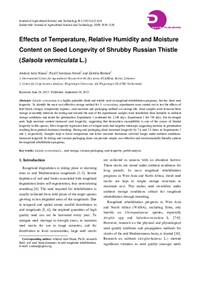Effects of Temperature, Relative Humidity and Moisture Content on Seed Longevity of Shrubby Russian Thistle (Salsola vermiculata L.)

Authors:
Salsola vermiculata is a highly palatable shrub and widely used in rangeland rehabilitation programs, but has short seed
longevity. To identify the most cost effective storage method for S. vermiculata, experiments were carried out to test the effects of
fruit bracts (wings), temperature regimes, seed moisture and packaging methods on storage life. Seed samples were removed from
storage at monthly intervals for testing and towards the end of the experiments samples were transferred from hermetic to ambient
storage conditions and tested for germination. Experiment 1 continued for 1,140 days, Experiment 2 for 720 days. For de-winged
seed, high moisture content increased seed longevity, suggesting that desiccation susceptibility is one of the causes of limited
longevity in this species. Most longevity regression lines of winged seeds had negative intercepts suggesting increase in germination
resulting from gradual dormancy-breaking. Drying and packaging alone increased longevity by 7.6 and 3.8 times in Experiments 1
and 2, respectively. Samples kept at lower temperature and lower moisture treatments survived longer under ambient conditions.
Increased longevity by drying and vacuum packaging alone can provide simple, cost effective and environmentally friendly options
for rangeland rehabilitation programs.
